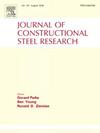SMA自复位人工可控塑性铰的抗震性能及设计方法
IF 4
2区 工程技术
Q1 CONSTRUCTION & BUILDING TECHNOLOGY
引用次数: 0
摘要
为了提高装配式建筑的可修复性,减少地震后的修复工作量,延长装配式建筑的使用寿命,本文设计了一种用于装配式梁柱节点的新型自复位人工可控塑性铰(SACPH),其材料为形状记忆合金(SMA)。建立了SACPH关节的理论设计方法。基于实验验证模型,利用有限元软件研究了不同SMA直径、长度和材料特性等设计参数下11个组合接头的滞回性能。结果表明,SACPH的最大残余变形量仅为2%。SACPH损伤主要集中在SMA筋的薄弱部位。与现浇框架相比,SACPH试件的平均屈服和峰值荷载分别降低20.95%和17.39%。当钢筋用量为现浇试件的20%时,其承载力可达到现浇试件的80%左右。增大SMA棒的直径,减小其长度,可以提高SACPH接头的承载能力和自复位能力。消能杆直径的适用范围为14mm ~ 22mm,长度的适用范围为225mm ~ 275mm。建立了SACPH节点屈服时承载力和位移预测的理论模型,理论结果与仿真结果吻合较好。本文章由计算机程序翻译,如有差异,请以英文原文为准。
Seismic performance and design methods of self-reset artificial controllable plastic hinge using SMA bars
To improve the repairability of prefabricated buildings, reduce the post-earthquake repair workload, and prolong the service life of prefabricated buildings, this paper designed a new type of self-reset artificial controllable plastic hinge (SACPH) for assembled beam-column joint, which is made of Shape Memory Alloy (SMA). A theoretical design method of the SACPH joint was established. The hysteretic performance of eleven assembled joints with different design parameters, such as different diameters, lengths and material properties of SMA, were studied by finite element software based on the experimental verification model. The results showed that the maximum residual deformation of SACPH was only 2 %. The damage of SACPH mainly concentrated on the weak area of the SMA bar. The average yield and peak loads of the SACPH specimen were 20.95 % and 17.39 % lower respectively, than those of the cast-in-place frame. When the amount of steel bars used in SACPH was 20 % of the cast-in-place specimen, the bearing capacity could reach about 80 % of the latter. Increasing the diameter of the SMA bar and reducing its the length could improve the bearing capacity and self-reset ability of SACPH joints. The applicable range of the diameter and the length of the energy dissipation bars were 14 mm to 22 mm and 225 mm to 275 mm, respectively. In addition, a theoretical model in predicting the bearing capacity and displacement of SACPH joints when they yield are established, and the theoretical results agreed well with the simulation results.
求助全文
通过发布文献求助,成功后即可免费获取论文全文。
去求助
来源期刊

Journal of Constructional Steel Research
工程技术-工程:土木
CiteScore
7.90
自引率
19.50%
发文量
550
审稿时长
46 days
期刊介绍:
The Journal of Constructional Steel Research provides an international forum for the presentation and discussion of the latest developments in structural steel research and their applications. It is aimed not only at researchers but also at those likely to be most affected by research results, i.e. designers and fabricators. Original papers of a high standard dealing with all aspects of steel research including theoretical and experimental research on elements, assemblages, connection and material properties are considered for publication.
 求助内容:
求助内容: 应助结果提醒方式:
应助结果提醒方式:


